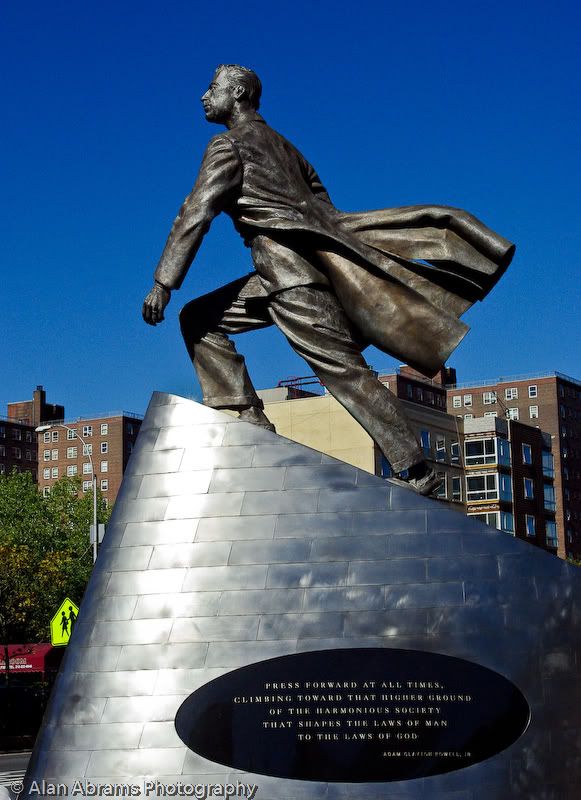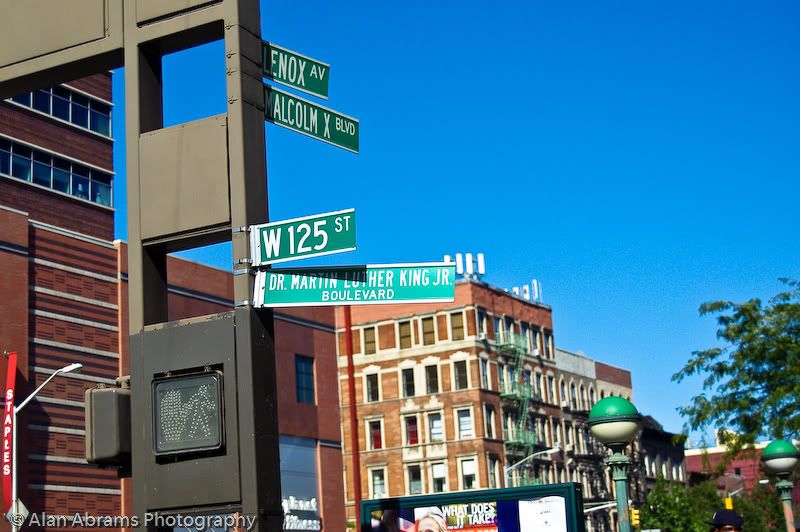 After the museum, we
After the museum, we strolled through Spanish Harlem and went to a store named Justo Botanica. It was founded in 1930 and is one of the oldest and best-known Botanicas
in East Harlem. A botanica carries religious, spiritual, and herbal
products for practitioners of Afro-Cuban Santeria, a mix of Catholicism
and Yoruba religious traditions (http://insidenewyork.com/2008/12/07/justo-botanica/). At first i was hesitant to go in there because i thought it would be against my religion but i went in there with an open mind because i knew that i wasn't going in there with any evil intentions. As soon as we walked in, we were greeted by Jose who was the owner of the store. He is well known in the community and is considered to be a witch doctor who can fix just about anything. He began telling us about the store and how he has helped a lot of people and he even have customers who come back and thanked him for what he has done; even doctors come to him. He told us how he was going to be moving soon due to gentrification and how the area is becoming overpriced and trendy. Even though i'm not a believer in another human being "fixing" my problems, i purchased a bracelet just to help him with his business because i know that he needs it. Also hearing George speak, i got to learn more an aspect of Hispanic culture other than my own.
strolled through Spanish Harlem and went to a store named Justo Botanica. It was founded in 1930 and is one of the oldest and best-known Botanicas
in East Harlem. A botanica carries religious, spiritual, and herbal
products for practitioners of Afro-Cuban Santeria, a mix of Catholicism
and Yoruba religious traditions (http://insidenewyork.com/2008/12/07/justo-botanica/). At first i was hesitant to go in there because i thought it would be against my religion but i went in there with an open mind because i knew that i wasn't going in there with any evil intentions. As soon as we walked in, we were greeted by Jose who was the owner of the store. He is well known in the community and is considered to be a witch doctor who can fix just about anything. He began telling us about the store and how he has helped a lot of people and he even have customers who come back and thanked him for what he has done; even doctors come to him. He told us how he was going to be moving soon due to gentrification and how the area is becoming overpriced and trendy. Even though i'm not a believer in another human being "fixing" my problems, i purchased a bracelet just to help him with his business because i know that he needs it. Also hearing George speak, i got to learn more an aspect of Hispanic culture other than my own.
 After our visit to Justo Botanica, we walked around East Harlem to explore its fascination collection of public art. As we were walking, we came across a mural an individual was painting and prof Mike asked about the mural and said " are you Manny Vega?" and to our surprise it was him. I had never heard of Manny Vega before and i thought it was cool that he was actually painting his own mural. Manny Vega is an American painter that was born and raised in the Bronx. Through his work, he portrays the history and traditions of the African Diaspora that exist in the United States, the Caribbean, and Latin America. The mural he was working on is called "Espiritu". He made a statement that captured my interest, he said " once an artist finishes the last piece of his art, it is not his anymore, it's for the public to make it their own". I thought this was a beautiful statement coming from and i could see the passion and his eagerness to create a place where people can recognize themselves as part of the community. Hopefully people will appreciate his work and not destroy it.
After our visit to Justo Botanica, we walked around East Harlem to explore its fascination collection of public art. As we were walking, we came across a mural an individual was painting and prof Mike asked about the mural and said " are you Manny Vega?" and to our surprise it was him. I had never heard of Manny Vega before and i thought it was cool that he was actually painting his own mural. Manny Vega is an American painter that was born and raised in the Bronx. Through his work, he portrays the history and traditions of the African Diaspora that exist in the United States, the Caribbean, and Latin America. The mural he was working on is called "Espiritu". He made a statement that captured my interest, he said " once an artist finishes the last piece of his art, it is not his anymore, it's for the public to make it their own". I thought this was a beautiful statement coming from and i could see the passion and his eagerness to create a place where people can recognize themselves as part of the community. Hopefully people will appreciate his work and not destroy it.Me and three of my classmates stopped at El Caribeno Restaurant to order some food.After i ordered my food and paid, i looked at the receipt and saw that i was charged $222.57 instead of $22.57. Good thing i looked at the receipt ( thanks to my lucky bracelet from Justo) and noticed it; i pretty much spent all of my 30 min on the phone with my bank trying to sort the situation out. I was so mad because i was starving and i didn't even get to eat and on top of that we had to wait for latecomers who decided to use the bathroom at the last minute. Once lunch was over, we walked across the northern part of Central Park. Central Park is the heartland of Manhattan and its landscape and scenery were man-made based on designs by Frederick Law Olmsted and Calvet Vaux (BG, p.279). From Central Park, we walk through the Conservatory Gardens. It is the park's only formal garden and is named for an elaborate greenhouse that was torn down in 1934 during the Depression as a cost cutting measure. Before it became a garden, it was a project that provided employment during the Depression. By the 1970s, the garden had fallen into disrepair and in 1982, Lynden B. Miller, a painter and garden designer took over and the following year the Central Park Conservancy began restoring and planting wildflowers and bulbs ( BG, p.297).From the beautiful Conservatory Gardens, we walked along the Central Park Reservoir into central Harlem, where our tour guide Tim awaited us as he gives us a background on the different historic sites in Harlem. He began the tour where we were overlooking the Apollo Theater and a statue of Clayton Powell Jr. The Apollo Theater was opened for whites only when the neighborhood was predominantly white and largely German-Jewish. In 1934, the neighborhood changed and Leo Brecher took over the Apollo and opened it to black audiences. That same year, the Apollo Theater offered Amateur Nights which launched the careers of Sarah Vaughn and Ella Fitzgerald, Stevie Wonder, Aretha Franklin, Billie Holiday, and Diana Ross (BG,p.440). I remember when NBC used to have Showtime at the Apollo every Saturday. I remember watching all the contestants who come on the show hoping to start their dreams. Some were good and some were bad even though they rubbed the tree, they still got boo'ed. The tour guide pointed to the Clayton's statue and we learned that he was the first African American to be elected to Congress and became a powerful national politician. He challenged the ban on the informal ban on black representatives using Capitol facilities reserved for white members. He took black constituents to dine with him in the "Whites Only" House restaurant (http://www.britannica.com/EBchecked/topic/473225/Adam-Clayton-Powell-Jr). Aside from that we also learned that 7th Avenue was named Adam Clayton Powell Jr. Boulevard shortly after he died in 1972 and that at first 6th Ave was named after James Lenox, who established the Lenox library, then later became known as Malcolm X Boulevard after Malcolm was assassinated. Another street that was named after a historical person was 125th St; although it is known as Martin Luther King Jr. Boulevard, people still call it 125th St. ( BG, p.439).Tim also pointed out beautiful brownstones that cost about 1 million to live in.




Our last historic site in Harlem was the Harriet Tubman statue.Harriet Tubman was an African American abolitionist who was born into slavery and rescued more than 70 slaves. The statue depicted the 70 slaves that she helped escaped to the North. After that we walked a 1000 a long winding flight of stairs through Morningside Park at 120 street to arrive at the beautiful Morningside Heights. Morningside Heights was mainly farmland and remained isolated until Columbus Avenue opened in 1880 ( BG, p.427). These flights felt like forever and by the time we all made it, we were all out of breath. Prof Mike had other plans for us but i think he felt sorry for us because we all looked dead after that horrendous walk up the stairs. Overall i enjoyed Harlem because the weather was nice and despite all the walking i learned a lot of things i didn't know about Harlem although I've been there before. My favorite part of the day was meeting Manny Vega!
No comments:
Post a Comment